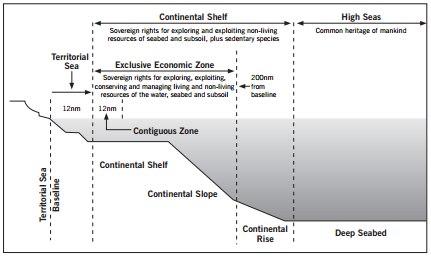Areas
Management of the sea is governed internationally by multilateral treaties, the foremost being the United Nations Convention on the Law of the Sea (UNCLOS). Under UNCLOS, New Zealand exercises different jurisdictional powers over four defined maritime areas ─ the territorial sea, the contiguous zone, the exclusive economic zone (EEZ) and the continental shelf – as shown in the figure below.

The territorial sea is part of New Zealand’s sovereign territory. This means that the government’s power to govern this marine area is the same as on land, although other states have rights established under international law, such as ‘innocent passage’ of their vessels. The territorial sea comprises the marine area within 12 nautical miles of low-water mark. In New Zealand, it encompasses 167,650 square kilometres.
2442
The contiguous zone lies on the seaward side of the territorial sea, extending from 12 to 24 nautical miles from the low-water mark. It overlaps with the EEZ. This is not part of New Zealand’s territory. But under UNCLOS, in addition to the rights New Zealand has in this area as part of the EEZ, New Zealand has the right to police the area to prevent or punish infringements (of customs, fiscal, immigration or sanitary laws and regulations) in its territory or territorial sea.
The EEZ is the largest of New Zealand’s marine areas, covering an area which extends from the outer edge of the territorial sea to 200 nautical miles from the low-water mark. In some places, New Zealand's EEZ extends over the edge of the continental shelf into deep ocean areas.
The EEZ is not part of New Zealand’s territory, but under UNCLOS, New Zealand has sovereign rights for the purpose of exploring, exploiting, conserving and managing all of its living and non-living natural resources. These resources include marine life, oil, gas and minerals and energy produced from water, currents and winds. Other countries retain the freedom of navigation and over-flight and can lay submarine cables and pipelines within New Zealand’s EEZ.
Where the outer edge of the continental shelf (which includes the continental slope and rise) extends beyond the EEZ, New Zealand has more limited rights. These only cover the exploitation of minerals, gas and other non-living resources within the seabed and subsoil as well as sedentary species on the seabed, but excluding mobile fish. When taking non-living resources such as minerals and petroleum from this part of the continental shelf, payments must be made to the International Seabed Authority. This authority was established, under UNCLOS, to control activities within areas of the seabed outside national jurisdiction.
2443
The United Nations Commission on the Limits of the Continental Shelf confirmed the boundary of New Zealand’s continental shelf in 2008. It includes approximately 1.7 million square kilometres of seabed outside the existing EEZ (about six times the area of our land mass). 2444 Because some parts of New Zealand’s EEZ and continental shelf overlap with areas claimed by other countries, the boundaries need to be agreed by treaty. New Zealand has signed a treaty with Australia to settle joint maritime boundaries but has yet to conclude maritime treaties with Fiji, Tonga and France (regarding New Caledonia).
The water column outside the territorial sea and EEZ of New Zealand and other countries is the high seas. All states have ‘freedom of the high seas’ which includes freedom of navigation, overflight, laying cables and pipelines, constructing artificial installations, fishing and scientific research.
The seabed and subsoil beyond the continental shelves of New Zealand and other countries is called The Area. This is not owned by any particular country but vested in humankind as a whole and administered by the International Seabed Authority. No state can claim or exercise sovereignty or sovereign rights over the Area.
-
WWF-New Zealand, 2009, 11
-
See http://www.isa.org.jm/en/about
Last updated at 2:50PM on February 6, 2018